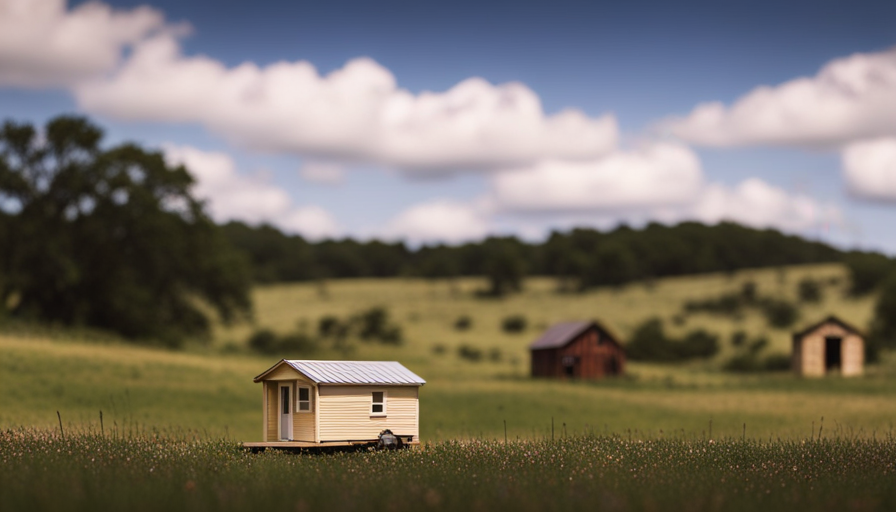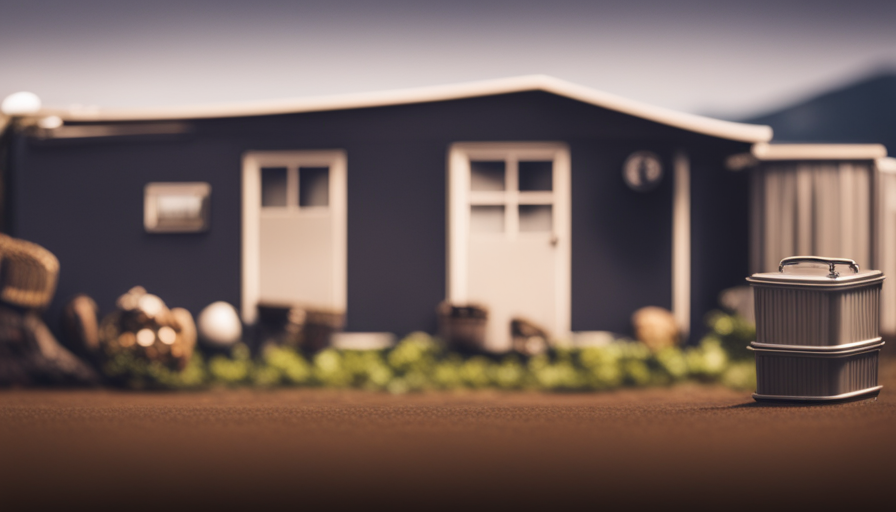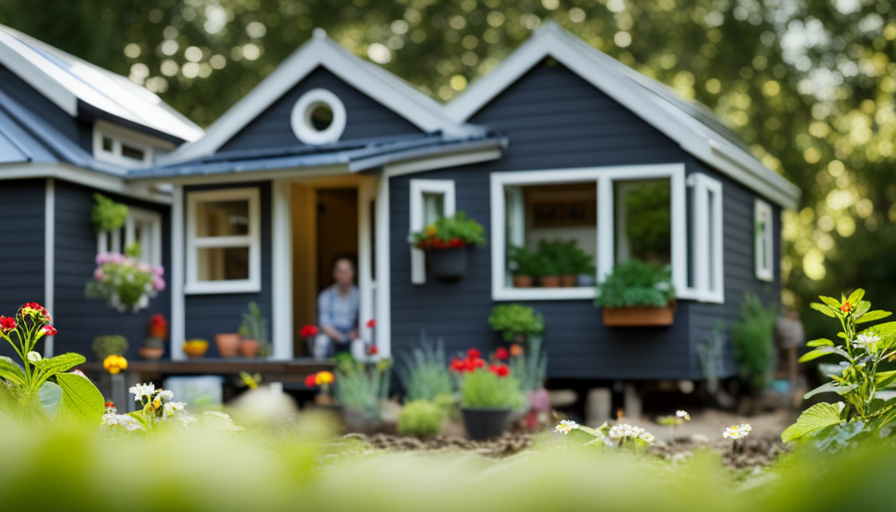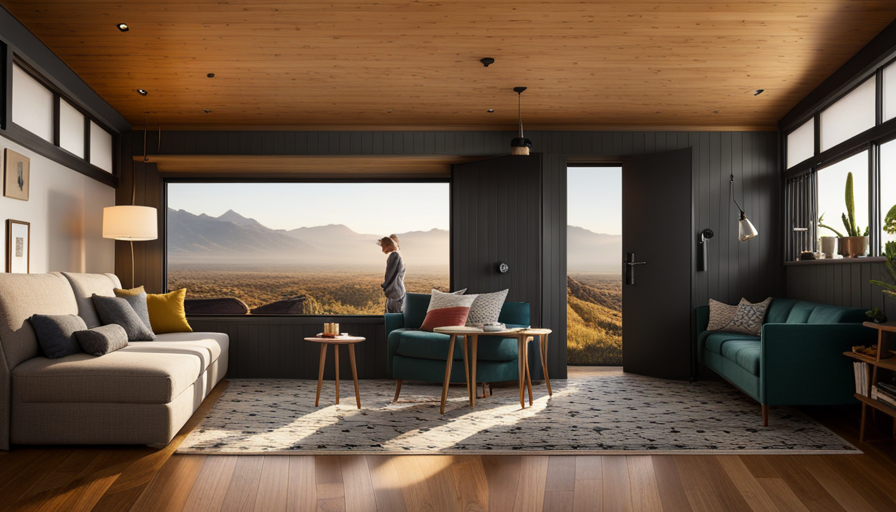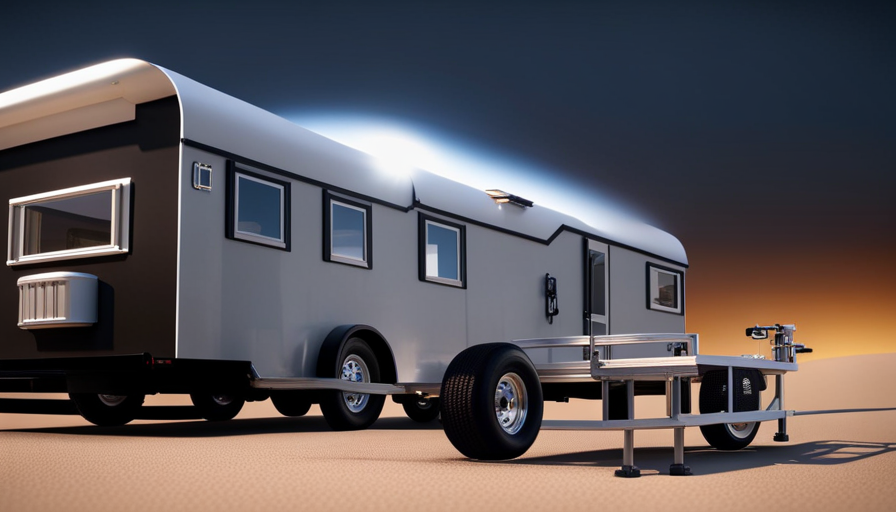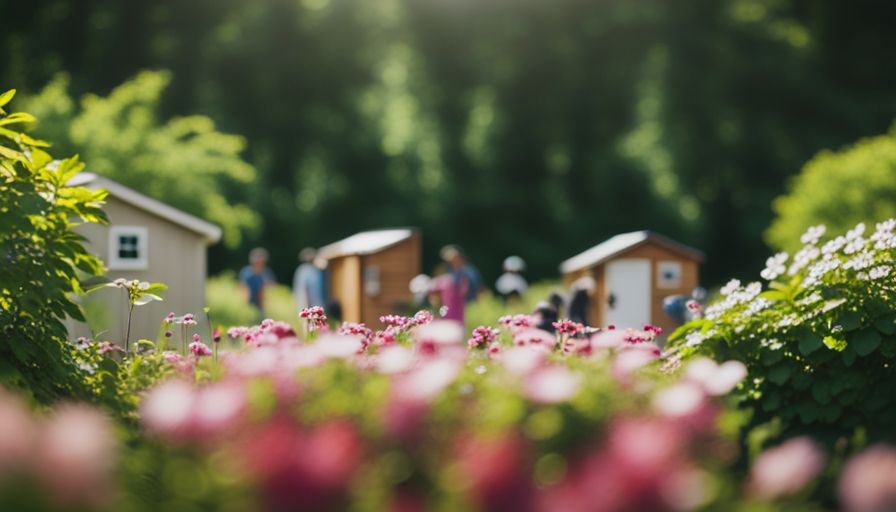In the expansive state of Texas, where the saying ‘everything’s bigger in Texas’ is widely embraced, this idea doesn’t necessarily apply to housing. In fact, the trend towards tiny house living is gaining momentum, as more Texans embrace the idea of living with less and simplifying their lifestyles.
But before you jump on the tiny house bandwagon, it’s important to understand the costs involved. Building a tiny house requires careful planning and budgeting, as every detail from construction materials to permits and utilities needs to be considered.
In this article, I will break down the costs associated with building a tiny house in Texas, providing you with a comprehensive guide to help you make informed decisions and avoid any financial surprises along the way.
So, grab your notepads and calculators, because we’re about to delve into the nitty-gritty of tiny house construction costs in the Lone Star State.
Key Takeaways
- Understanding zoning regulations and choosing the right construction method are crucial.
- Researching and comparing different contractors is essential.
- Calculating material expenses considering location, availability, and quality.
- Budgeting for unexpected expenses and having a contingency fund.
Understanding the Basics of Tiny House Construction
Building a tiny house in Texas is an exciting and budget-friendly way to embrace minimalist living. When embarking on this journey, it’s crucial to understand zoning regulations and choose the right construction method.
Firstly, familiarize yourself with the local zoning regulations to ensure that you can legally build a tiny house on your desired property. Different areas in Texas may have specific requirements and restrictions, such as minimum square footage or setbacks from property lines. Researching and understanding these regulations will help you avoid any potential issues down the road.
Next, choosing the right construction method is essential for building a tiny house that suits your needs and budget. There are various construction methods available, including traditional stick-built, modular, and panelized construction. Each method has its advantages and cost considerations. For example, stick-built construction allows for more customization but may require more time and labor. On the other hand, modular construction offers faster assembly but may limit design options. Consider your preferences and budget when selecting the construction method that best fits your vision.
By understanding zoning regulations and selecting the appropriate construction method, you can lay the foundation for a successful tiny house project in Texas. After grasping these basics, the next step is to delve deeper into researching local regulations and permits to ensure a smooth and hassle-free construction process.
Researching Local Regulations and Permits
Researching local regulations and permits in Texas can be an enlightening adventure for those looking to construct a charming small abode. When it comes to building a tiny house in Texas, it’s crucial to understand and comply with the local zoning regulations. This involves researching the specific requirements and restrictions set by the city or county where you plan to build.
Some areas may have limitations on the size and height of the structure, as well as setback requirements from property lines and other structures.
Additionally, finding suitable land for your tiny house is another important aspect of the research process. You’ll need to consider factors such as accessibility, proximity to amenities, and the availability of utilities. It’s advisable to consult with real estate agents or online platforms that specialize in tiny house-friendly properties. They can help you identify areas where tiny houses are permitted and provide information on land prices.
Once you’ve thoroughly researched local regulations and found suitable land for your tiny house, the next step is estimating the cost of land. This will be explored in the next section.
Estimating the Cost of Land
Once you’ve scoped out the perfect spot for your dream getaway, it’s time to delve into estimating just how much that prime piece of land will set you back. Estimating the cost of land is a crucial step in determining the overall budget for building a tiny house in Texas.
To begin, it’s important to research and compare land values in different areas to find affordable options. Factors such as location, size, and zoning regulations can greatly impact the price of land. Consulting real estate websites and local property listings can provide valuable insights into current land prices. Additionally, reaching out to local real estate agents or property owners can help gather more specific information.
It’s also essential to consider the potential for future development or resale value when estimating land costs. By carefully analyzing these factors and conducting thorough research, you can make a more accurate estimate of the land expenses for your tiny house project.
With the land value estimated, it’s time to move on to budgeting for labor and professional services, ensuring a comprehensive plan for your dream tiny house.
Budgeting for Labor and Professional Services
To ensure a comprehensive plan for your dream getaway, you’ll need to consider budgeting for the skilled labor and professional services required for your project. When it comes to building a tiny house in Texas, one aspect of the budget that shouldn’t be overlooked is interior design.
While it may seem like a small detail, the cost of hiring an interior designer can add up quickly. However, there are ways to find affordable options without sacrificing quality. Consider reaching out to local design schools or freelancers who may offer their services at a lower cost. Additionally, you can utilize online resources and platforms that connect homeowners with affordable interior designers.
Another important consideration is finding contractors who can bring your vision to life within your budget. It’s crucial to research and compare different contractors to ensure you are getting the best value for your money. Look for contractors with experience in building tiny houses and ask for references or portfolios of their previous work.
By carefully budgeting for interior design and finding affordable contractors, you can create a beautiful and functional tiny house without breaking the bank.
Moving on to calculating material expenses, it’s important to consider the cost of the materials needed for construction.
Calculating Material Expenses
When calculating material expenses for building a tiny house in Texas, it’s important to consider the cost of building materials in the state. Texas has a wide range of construction material prices, with factors such as location, availability, and quality influencing the costs.
In order to stay within budget, sourcing affordable and sustainable options is crucial, as it allows for cost savings while also promoting environmentally friendly choices. Additionally, setting aside a separate budget for furniture and appliances is essential, as these items can significantly impact the overall cost of the project.
Cost of Building Materials in Texas
Although building materials in Texas can vary in price, it’s important to investigate the theory that sourcing materials locally could potentially lower the overall cost of constructing a tiny house.
One factor to consider is the cost of transportation for building materials. Depending on the distance, this expense can significantly impact the budget.
Additionally, comparing prices of building materials in different regions of Texas is crucial. Certain areas may offer more affordable options, allowing for cost savings.
By carefully researching and comparing prices, it is possible to find the best deals on materials and reduce construction costs.
In the next section, I’ll explore sourcing affordable and sustainable options to further optimize the cost of building a tiny house in Texas.
Sourcing Affordable and Sustainable Options
Sourcing affordable and sustainable options for materials can lead to significant savings and a more environmentally friendly approach to building a tiny house in Texas. When it comes to materials, opting for affordable eco-friendly options is a smart choice.
For example, using reclaimed wood for flooring and furniture can add a unique and rustic touch to your tiny house while reducing costs. Additionally, consider using recycled steel for structural elements, which is not only durable but also eco-friendly.
Another cost-effective option is to explore creative space-saving design ideas, such as utilizing multipurpose furniture or incorporating built-in storage solutions. These design choices not only save money but also maximize the available space in your tiny house.
Transitioning into the subsequent section about the furniture and appliance budget, it’s important to consider affordable options that complement your eco-friendly materials and design choices.
Furniture and Appliance Budget
Creating a stylish and functional tiny haven in Texas means carefully curating a furniture and appliance budget that takes your breath away with its affordability and efficiency.
When it comes to furniture selection, opting for multi-functional pieces is key. Look for items that can serve multiple purposes, such as a sofa that doubles as a guest bed or a coffee table with hidden storage compartments. This way, you can maximize the use of your limited space without sacrificing comfort or style.
Additionally, consider purchasing second-hand furniture or exploring local thrift stores for unique and affordable finds.
As for appliance installation, energy-efficient options are a must. Look for appliances with high energy star ratings to minimize your utility costs.
Transitioning into the next section, factoring in utilities and off-grid options can further enhance the sustainability of your tiny home.
Factoring in Utilities and Off-Grid Options
Factoring in utilities and off-grid options, it’s important to consider the additional costs that come with building a tiny house in Texas. When it comes to off-grid living, there are several renewable energy options to consider.
-
Solar power: Installing solar panels can provide a sustainable and cost-effective way to power your tiny house. Texas has abundant sunshine, making it an ideal location for harnessing solar energy.
-
Rainwater harvesting: Texas is known for its unpredictable weather patterns, so collecting rainwater is a smart choice for off-grid living. This allows you to have a self-sufficient water supply and reduces reliance on traditional water sources.
-
Composting toilets: In order to minimize water usage and be more environmentally friendly, many tiny house owners opt for composting toilets. These toilets break down waste into compost, which can be used as fertilizer for plants.
Considering these off-grid options is crucial for calculating the overall cost of building a tiny house in Texas. By incorporating renewable energy sources and reducing water consumption, you can create a sustainable and eco-friendly living space.
Transitioning into the next section about considering additional amenities and features, it’s important to think about the overall comfort and functionality of your tiny house.
Considering Additional Amenities and Features
When it comes to considering additional amenities and features for a tiny house, there are three key points that I find particularly important.
First, outdoor spaces and landscaping can greatly enhance the overall living experience, but it’s crucial to factor in the cost and maintenance of these areas.
Second, storage solutions and organization are essential in maximizing the limited space available, so investing in smart storage solutions can greatly improve the functionality of the tiny house.
Lastly, customization and personalization allow you to make the tiny house truly your own, but it’s important to balance your desires with practicality and cost considerations.
Outdoor Spaces and Landscaping
To maximize your outdoor space and create a beautiful landscape for your tiny house in Texas, you can incorporate features like a patio with a fire pit, a small garden with native plants, and a cozy seating area with string lights to create a warm and inviting atmosphere. For example, imagine enjoying a summer evening on your Texas tiny house patio, roasting marshmallows over the fire pit, surrounded by colorful flowers and the sound of chirping birds.
To further enhance your outdoor entertainment, you can set up a table with a built-in grill for barbecues and outdoor dining. The sustainable gardening aspect can be achieved by using rainwater collection systems and choosing native plants that require less water and maintenance. This not only reduces your environmental impact but also saves you money on water bills. Additionally, incorporating a composting area can help you create nutrient-rich soil for your garden.
By carefully planning and designing your outdoor spaces and landscaping, you can create a serene and enjoyable environment around your Texas tiny house. Moving on to the next section about storage solutions and organization, let’s explore ways to maximize your indoor space efficiently.
Storage Solutions and Organization
Now that we’ve discussed outdoor spaces and landscaping, let’s move on to storage solutions and organization in a tiny house. In order to maximize space in a tiny house, it’s essential to have efficient storage solutions. There are several clever ways to achieve this:
-
Built-in shelves and cabinets: These can be customized to fit the available space and provide ample storage for belongings.
-
Multi-functional furniture: Opting for furniture pieces that serve multiple purposes, such as a sofa that can be converted into a bed or a coffee table with hidden storage compartments, can help save space.
-
Utilizing vertical space: Installing wall-mounted shelves or using hanging organizers can make use of vertical space that would otherwise be wasted.
-
Creative storage solutions: From under-stair storage to hidden drawers in stairs, there are numerous creative ways to incorporate storage in every nook and cranny.
By implementing these storage solutions, you can make the most of the limited space in a tiny house. Speaking of customization and personalization, let’s explore how to tailor a tiny house to your unique preferences.
Customization and Personalization
If you want to truly make your tiny house your own, there are endless possibilities for customization and personalization. When it comes to customization options, you can choose from a wide range of features and upgrades that suit your taste and lifestyle. From choosing the type of flooring, to selecting the style of cabinets and countertops, to deciding on the color scheme, every aspect of your tiny house can be tailored to your preferences.
Additionally, there are personalization ideas that can add a unique touch to your space, such as incorporating artwork, installing custom storage solutions, or adding personalized decor items. The key is to carefully consider your needs and desires, and work with a builder or designer who can help bring your vision to life.
So, once you have explored the customization and personalization options, it’s important to also budget for unexpected expenses in order to ensure a smooth and successful build.
Budgeting for Unexpected Expenses
Surprises can really throw a wrench into your budget when building a tiny house in Texas. That’s why it’s crucial to plan for unexpected expenses and have a contingency fund in place. While it’s impossible to predict every unforeseen cost, having a financial buffer can help alleviate some of the stress that comes with unexpected maintenance and repairs.
To give you an idea of the potential expenses you might encounter, take a look at the table below:
| Unexpected Expenses | Estimated Cost ($) |
|---|---|
| Structural issues | 2,000 – 5,000 |
| Plumbing problems | 500 – 1,500 |
| Electrical repairs | 1,000 – 2,500 |
| HVAC system breakdown | 2,500 – 5,000 |
These are just a few examples of the unexpected costs that could arise during the construction process. It’s important to set aside a contingency fund of at least 10% of your total budget to cover these expenses. By planning ahead and having a financial cushion, you’ll be better prepared to handle any surprises that come your way.
Now that we’ve discussed budgeting for unexpected expenses, let’s explore the various financing options available for tiny house construction.
Financing Options for Tiny House Construction
A variety of financing options are available to help you bring your tiny house construction dreams to life, giving you the financial flexibility to make your vision a reality.
When it comes to tiny house financing, there are several loan options to consider. One option is a personal loan, which can be used for a variety of purposes, including tiny house construction. Personal loans typically have fixed interest rates and repayment terms, making it easier to budget for your project.
Another option is a construction loan, specifically designed for building homes. These loans provide funding in stages as your construction progresses, allowing you to pay for materials and labor as you go.
If you already own a piece of land, you may be able to use it as collateral for a land equity loan. This type of loan uses the value of your land to secure the financing for your tiny house construction.
Additionally, some tiny house builders offer in-house financing options, allowing you to finance your project directly through them.
Before choosing a financing option, it’s important to thoroughly research and compare interest rates, terms, and eligibility requirements. By exploring these different loan options, you can find the best financing solution to bring your tiny house construction plans to life.
Frequently Asked Questions
What are some common challenges faced when building a tiny house in Texas?
When building a tiny house in Texas, there are common challenges and construction difficulties to consider.
Some of these challenges include zoning regulations, obtaining building permits, and finding suitable land for construction.
Additionally, sourcing materials and skilled labor can be a challenge, as well as managing the logistics of transporting and assembling the tiny house.
These challenges require careful planning and coordination to ensure a successful and smooth construction process.
Are there any specific zoning regulations or restrictions for tiny houses in Texas?
There are specific zoning regulations and legal requirements for tiny houses in Texas. These regulations vary depending on the location within the state.
It’s important to research and comply with local zoning ordinances before building a tiny house. Some common requirements include minimum square footage, foundation type, and utilities.
It is recommended to consult with local authorities or a professional to ensure compliance with all zoning regulations and legal requirements.
What are the average maintenance costs for a tiny house in Texas?
On average, the maintenance costs for a tiny house in Texas are around $500 to $1,000 per year. However, you can reduce these expenses with some cost-saving tips. Regularly inspect and maintain the roof, plumbing, and electrical systems to prevent costly repairs. Additionally, use energy-efficient appliances and install solar panels to lower utility bills. Properly insulate the house and use durable materials to minimize long-term maintenance costs.
Are there any grants or subsidies available for building a tiny house in Texas?
Grants and financial assistance can be a game-changer when it comes to building a tiny house in Texas. There are various programs available that can help alleviate the costs. These grants provide substantial financial support, making the dream of owning a tiny house more attainable.
With these funds, you can fund a portion of the construction or even cover the entire cost, making it an incredible opportunity for aspiring tiny house owners.
How long does it typically take to build a tiny house in Texas from start to finish?
Typically, building a tiny house in Texas takes around 3 to 6 months from start to finish. The building timeline can vary depending on factors such as the complexity of the design, size of the tiny house, availability of materials, and the builder’s experience.
During this time, various stages of the construction process are undertaken, including site preparation, foundation installation, framing, electrical and plumbing installation, insulation, interior finishing, and exterior detailing.
Conclusion
In conclusion, building a tiny house in Texas can be a wild adventure that’ll take you on a rollercoaster of emotions and expenses.
From navigating local regulations to budgeting for unexpected surprises, every step of the process will test your determination and resilience.
With meticulous planning and a keen eye for detail, you can embark on this journey armed with the knowledge of the costs involved.
So buckle up and get ready for the ride of a lifetime as you bring your dream tiny house to life in the Lone Star State!
Hi, I’m Emma. I’m the Editor in Chief of Tiny House 43, a blog all about tiny houses. While tree houses are often associated with childhood, they can be the perfect adult retreat. They offer a cozy space to relax and unwind, surrounded by nature. And since they’re typically built on stilts or raised platforms, they offer stunning views that traditional homes simply can’t match. If you’re looking for a unique and romantic getaway, a tree house tiny house might just be the perfect option.
